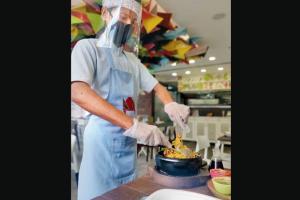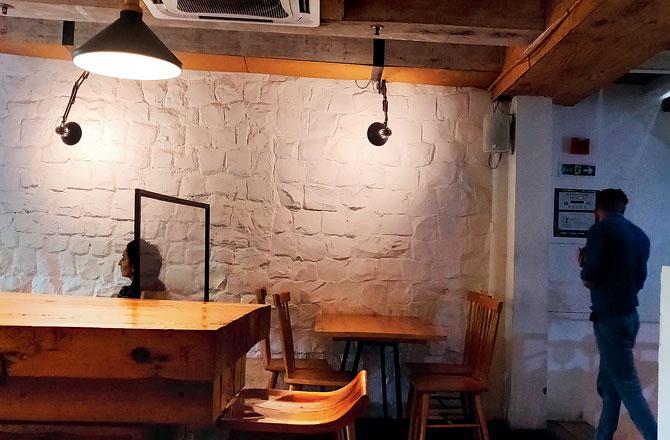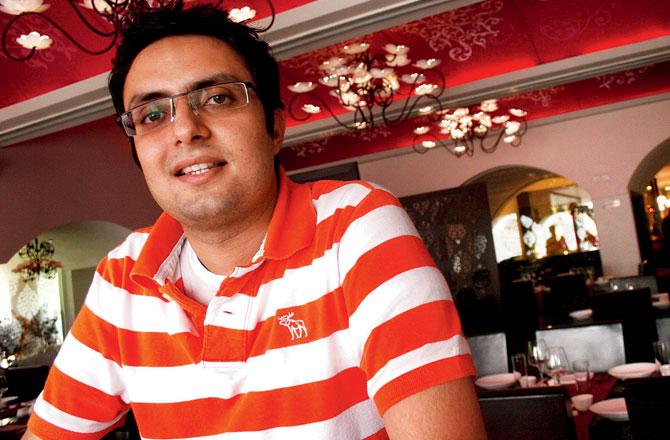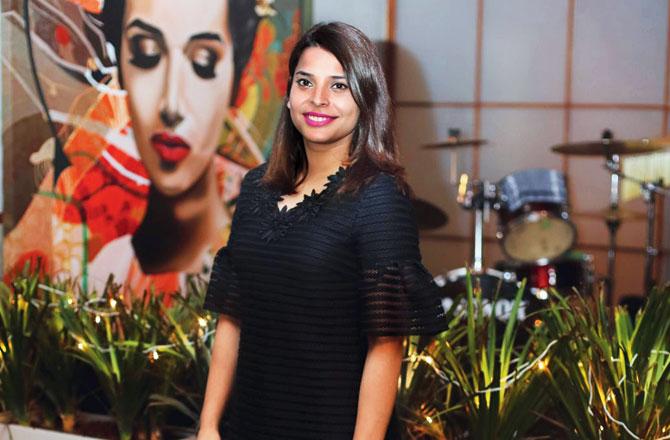While Mumbai restaurants are barely two weeks old in the Unlock game, Delhi has been at it since June. The capital offers its megalopolis sister a handy lesson or two in getting it right

Wearing the mandatory protective gear, a staffer at Yum Yum Cha serves a meal
 To eat out or not? Be it Mumbai or Delhi, this remains the question of the hour. Early this month, Delhi CM Arvind Kejriwal announced directives to allow restaurants to operate 24x7. Last week, the Capital reported 3,000 new COVID-19 cases. Both announcements reflect the mood of the restaurant industry that continues to grapple with challenges to find its feet in a new normal.
To eat out or not? Be it Mumbai or Delhi, this remains the question of the hour. Early this month, Delhi CM Arvind Kejriwal announced directives to allow restaurants to operate 24x7. Last week, the Capital reported 3,000 new COVID-19 cases. Both announcements reflect the mood of the restaurant industry that continues to grapple with challenges to find its feet in a new normal.
ADVERTISEMENT
In August, this writer was in the Capital and decided to experience the 'unlocking' of restaurants. While the periodic spurt in infections may affect Delhi's hospitality scene, there's a lot to be gleaned from its experience.

Condiments are kept in a plastic case within the container at the restaurant
With mask and gloves on, and armed with sanitiser, we drove into 32 Avenue, Gurgaon's food hub. The staffer at the entrance aimed a temperature gun at my forehead. It showed 103F, way higher than normal. "Aap side pe aayein. Dhoop hai na, hota hai," she smiled after I threw her the oh-gosh-do-I-have-COVID look. In five minutes, she repeated the exercise and my reading was at 96F.
The usually bustling arena wore an empty look. In six months, this was my first outing and I was wary. At Fifth Avenue Café, I ordered aglio e olio from the hardbound menu. A family of three were celebrating a birthday with Nutella cheesecake, but they entered and left within 15 minutes. They made a joke on their way out, too: "Shortest birthday party, ever."

The plates came wrapped in paper at United Coffee House
The first outing was spent in silence. The second one was better; this time at Khan Market's Perch. While a guard sprayed some sanitiser on my palms, my contact details were not noted.
Here, I saw a semblance of normalcy—a mother and daughter were enjoying their coffee and a couple was on a date. The community table had a woman working on her laptop. The tables had the Zomato QR code that allow you to scan the menu, order and pay, all from your phone. The early days of lockdown, it had been turned off that day. We were better off mentally than the first visit, but the meal was average. Home kitchens have upped the cooking game, and restaurateurs will have to push the envelope when it comes to wooing customers.

Plexiglass partitions separating each table at Perch, Khan Market
Tarun Sibal, who was one of the founders of Café Staywoke in Gurgaon's South Point Mall and currently runs Titlie, a culinary bar in Vagator, says, "Going out to eat is a guilty pleasure today, unlike going to get groceries, which is an essential exercise. We need to consider a customer's mindset. A restaurant should leave a customer feeling that he wants to return. People want to forget this pandemic. While it is an uphill task for the hospitality sector across the country, and that won't change anytime soon, those who focus on a process-oriented profit and loss will do better."
On the restaurant's part, capturing the data of every customer, maintaining social distancing and ensuring that the staff wears masks and shields is non-negotiable. Sibal has created a shorter menu, and works with half the staff; three in the front house and another three in the kitchen. "People are not as finicky once they enter. It is the exercise of drawing them in that needs attention. For this, the food has to be wow. People want to indulge, they've been holed up in their homes for over five months," says Sibal, adding, "Gurgaon has a millennial crowd, so we're doing umami flavours found in the double decker tenderloin Thai herbed burgers and nostalgic pancakes."

The usually bustling Khan Market wears a deserted look
The staffers have no cross function; each has an assigned station. They wash and sanitise their hands more often and keep the Arogya Setu app updated.
The level of hygiene depends on the segment the eatery belongs to, thinks Sibal. "MKT Market Café at Chanakya is a high-end destination with a high sense of hygiene, where plates come individually wrapped in eco-friendly covers and a bag to place your sanitisers," says Sibal. He believes malls have suffered the most. "People are dropping by stand-alone eateries and terraces. Drive-throughs and road-side QSRs that allow customers to eat in their cars are doing the best currently."

Varun Tuli
Last week, we saw Qualia set up a QurbSide seating experience in Lower Parel and a post on restaurateur Gauri Devidayal's Instagram also dropped a similar hint of introducing curbside dining at The Table in Colaba.
Vaibhav Singh of Perch, a café and wine bar with outposts in Delhi and Mumbai, says the two cities are stark opposites. "Delhi is spread out, Mumbai is much denser. From our Delhi experience, we learnt that our efficiency improved once we knew what we were doing," says Singh, who calls the new workings similar to directing a staged theatre performance. "We have divided the staff into two teams, A and B. This is similar to how hospitals function. The kitchen is a tighter space, so we are doing a concise menu. We have trained staff to be cautious but not overbearing. They have to, for instance, keep a check on customers who sometimes walk up and down the floor to take a phone call."

Avantika Sinha
Yum Yum Cha in Cyber Hub is a case in point. At the entrance, I logged in my details and by the time I was seated at a table, two-feet away from the next, the menu was pinged to my WhatsApp number. The table had two plastic mineral water bottles and the condiments were in disposable containers. The staff was self-assured, smiling and geared in masks and shields. They were efficiently going about their duties and their confidence put us at ease. I skipped the sushi and ordered a rice bowl and noodle wok. Dramatic confession: the food overwhelmed me.
The nutty sambal rice and the wok-tossed veggies and noodles opened the floodgates of taste nostalgia. I had mastered tawa fried rice at home, but I sorely missed this. All the food came in double plates—ceramic plates holding sugarcane fibre disposable plates. We walked out feeling well fed, and well attended.
Next, the owner of Yum Yum Cha, Varun Tuli, hopes to set up bubble cubicles to create seating segments in the coming months. "We opened on June 8, while our delivery service, under the name of Noshi, was on since April. Since alcohol is off the menu, the food has to be top notch. This is the time when you have to build the repeat clientele from a local area pool," says Tuli, who, over the years, has invested in automated systems for kitchen processes.
Aerocity in Delhi was the first to get maximum movement of crowds in its three World Mark Towers. While owner of Kampai, Avantika Sinha wasn't excited when the move to open restaurants was passed, now she thinks the city has adapted well. "Ours is a high-end establishment and most of our clients are expats, so there is deep paranoia to step out. Restaurateurs have to take the initial hit until people start trusting again. They have spent a lot of time in isolation." Since they opened in August, they have had a cover of 75 and are operating at 50 per cent capacity. "What works in our favour is that we have private dining sections. Our outdoor space is receiving a better response."
The days when I could unwind for hours at a café are gone. But those who made the extra effort to make us feel safe and served us food with flavours to remember, got our nod for a consideration to return.
Tuli has parting advice for fellow restaurateurs: "To those sitting on the fence, I say, please open. People will come."
Keep scrolling to read more news
Catch up on all the latest Mumbai news, crime news, current affairs, and a complete guide from food to things to do and events across Mumbai. Also download the new mid-day Android and iOS apps to get latest updates.
Mid-Day is now on Telegram. Click here to join our channel (@middayinfomedialtd) and stay updated with the latest news
 Subscribe today by clicking the link and stay updated with the latest news!" Click here!
Subscribe today by clicking the link and stay updated with the latest news!" Click here!






